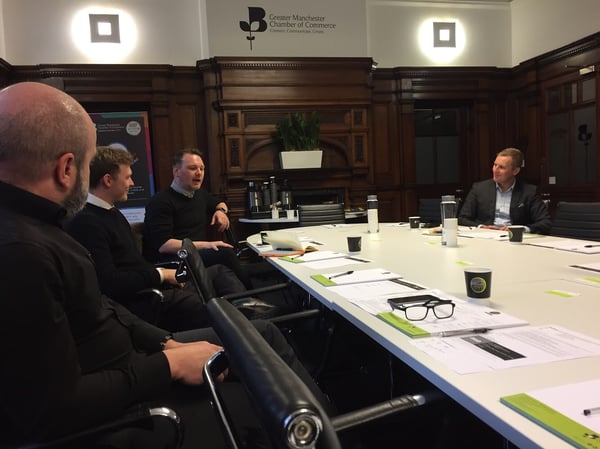Manchester Business Heads Debate the Evolution of the Workplace
The Greater Manchester Chamber of Commerce (GMCC) invited business leaders to a round-table event to debate the 'Modern Workplace'. Representing five sectors, they explored:
- What is the modern workplace?
- How can technology promote a positive workplace?
- What are the barriers to introducing new tech?
- What’s the best advice for implementing new tech?
- What does the future of digital transformation look like?
- To prepare, what should we be doing now?
We share their perspectives here.
Nick Isherwood of IT Lab and David Bowman of Content and Code gave the technologists' view.
Jacob Kane of AFEX represented the payments industry. Malcolm Struthers of BNY Mellon spoke for the financial services sector.
Andrea Kelly from the NatWest gave the commercial banking sector standpoint. Mandy Parkinson of the Manchester Metropolitan University shared the higher education outlook.
Chris Fletcher of the GMCC gave the chamber assessment.
What is the modern workplace?

Modern Workplace round-table at the GMCC
The Technologists’ View
It’s about ‘making the complex simple’. The modern workplace fosters collaboration and creativity. It delivers the connectivity and flexibility today’s workers want.
The Payments Industry View
It’s a space which empowers people to do their best work and get the most from their time in the office.
Fast global connectivity is vital to balance issues arising from time zones and distance.
The Financial Services Sector View
It’s an office space which meets the new and evolving needs of a business. It facilitates productivity and collaboration, but it’s not the focus. The modern workplace helps people work effectively and deliver higher value.
The Commercial Banking Sector View
It’s all about flexibility. The modern workplace is compatible with lifestyle while maintaining engagement – e.g. remote working.
It’s vital not to lose the shared group aspect through which we learn best. By allowing a balance, it helps shape the most efficient and flexible working environment.
How Can Technology Promote a Positive Workplace?
The Technologists’ View
Having the right tools helps employees feel valued and frees them to work productively. It’s important they’re not let down by your digital infrastructure. System reliability is paramount for engagement and productivity.
For organisations with mobile workers, connectivity is crucial. For example, 80% of Manchester Airport’s workforce isn’t office based.
Technology bridges the gap between head office and the employee population, ensuring consistency, engagement and efficiency.
The Financial Services Sector View
A contemporary, flexible workplace can improve a company’s brand image. Culture influences how a business is perceived.
The Payments Industry View
Technology enables a collaborative, innovative and productive culture. The best culture attracts and retains talent.
The Commercial Banking Sector View
The technology intrinsic to a modern workplace enables access to processes and learning. The right tech keeps the workplace innovating and developing.
Modern working methods cut costs. For example, by replacing travel fares with Skype calls and video conferencing. Technology makes it easier to stay connected across locations without losing a collaborative ethos.
What are the Barriers to Introducing New Tech to the Workplace?
The Technologists’ View
Ensuring everyone is digitally linked can be a challenge. In a world which expects connectivity, remote working poses problems.
Integrate technology from the top down and lead by example. Peer to peer teaching and digital mentors should be on hand to provide the time and guidance needed.
The Higher Education Sector View
A significant barrier to technology is making it stick in the workplace. Including employees throughout the implementation helps adoption.
Sentiment towards hot-desking can be an issue. Middle managers may not support remote working because they don’t trust their teams.
What’s the Best Advice for Rolling Out New Tech in the Workplace?
The Technologists’ View
To deliver innovation, the roll-out plan is often more important than the tech itself. Communicate the goals of the technology during introduction.
To maintain the change, a company must consistently manage and maintain its IT. A regular cycle of implementation will ensure the software sticks through business change and staff recruitment.
The goal of technology is to make people’s lives easier, not more frustrating. The digital revolution will simplify processes, encourage innovation and give businesses a competitive edge.
The Financial Services Sector View
Planning digital change involves a thorough introductory strategy, which caters for all demographics and roles, as employees often respond differently to different methods.
Metrics can be hugely useful in this process. It’s imperative to gauge engagement continuously. All manner of external factors can influence the traditional annual survey format. The resulting information should become central to the business strategy.
The Chamber View
To determine whether technology has met business goals and expectations, you must be able to measure the ROI. There’s more than one way to approach how that looks.
The Commercial Banking Sector View
Another way to measure the return on digital investments is to look at the consequences of not engaging with a technology. Take travel bans and digital banking; it’s easy to measure savings to the business and balance the cost of technology.
What Does The Future of Digital Transformation Look Like? To Prepare, What Should You Be Doing Now?
The Technologists’ View
The future of technology will focus on problem-solving. Look closely at business goals, aims and barriers. See what could help people become more efficient or productive and make their lives better.
It must be about applications joining together and platforms working seamlessly as one. Technology aims to make it easier to consume information and create secure environments that are straightforward to access.
Leaps in artificial intelligence are finding practical applications in everyday life. AI centres on finding ways to relate technology to common problems, to simplify life and business.
The fears expressed by the financial services sector (automation replacing jobs) are common. It’s important to remember that roles exist now which never developed for centuries. With every industrial revolution, some sectors will decline, but new opportunities will advance.
Roles won’t disappear, but skills will change as the industrial landscape does. As we become more focused on IT, skills to manage consumer experience and maintain the technology will become increasingly important.
The emphasis should be on schools and communities to unlock the skills needed in 10-15 years. Prepare the next generation and give them the best chance to work at the forefront of the digital age, particularly in Manchester.
The Higher Education Sector View
It’s essential not to introduce technology for the sake of it, and to consider the needs of different roles. Not all functions need every new innovative product, and it can hinder the success of the useful technology.
The Financial Services Sector View
There’s widespread concern over automation replacing employee roles and the potential impact on unemployment. This fear can make employees resistant to digital change.
Due to its well-established reputation and expertise in the digital sphere, Greater Manchester is the perfect hub to prepare for the industry shift.
The Commercial Banking Sector View
To adapt to the changing times, businesses need confidence and the support to foster continuous innovation and re-skill. The opportunities are plentiful for those companies which embrace change.
The Chamber View
Greater Manchester demands a cultural and infrastructural change if it’s to support a new data economy, clean growth and attract new businesses and investment.
Flexible and remote working will ease congestion and infrastructural demands on the city, as well as drawing new talent to the region.
Conclusion
As businesses face increasing and diverse challenges, the state of the workplace has a profound impact on competitive advantage, talent attraction and sustainable growth. A contemporary and flexible digital environment – the modern workplace - is crucial to meeting these challenges.







